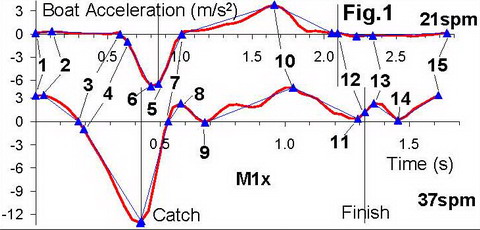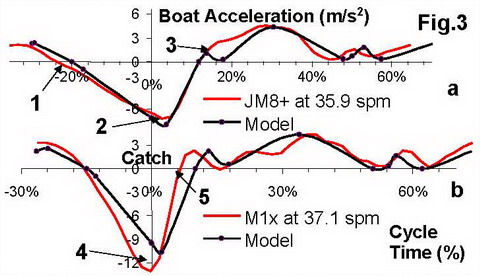Modelling of boat acceleration

During our BioRow data analysis and feedback, we present target curves for force, blade work and body segment velocities (RBN 2017/2, 2018/3-4). Coaches and rowers sometimes ask: “Why are targets for the boat acceleration curve are not presented?”.
The difficulty with modelling the boat acceleration (BA) curve is that both its magnitude and shape are highly dependent on the stroke rate and boat type, so this would be a fairly complex adjustable model. Here is an attempt to solve this problem and develop a method of boat acceleration modelling.

15 criteria points are identified on the curves, with each point defined by its magnitude (m/s2) and timing (s or % of the stroke cycle):
- Cycle Start, defined by the perpendicular oar position during recovery.
- Positive peak during recovery.
- Zero before catch, when BA changes sign from positive to negative.
- Value -1 m/s2 before the catch was added because BA may remain negative during recovery, so point 3 could be absent.
- Catch, when the oar changes direction from recovery to drive.
- Negative peak, which could happen before, after, or at the same time as the catch.
- Zero after catch, when BA changes sign from negative to positive.
- First peak - this may be absent in some crews at low stroke rates.
- Drive hump is related to point 8 and may also be absent.
- Positive peak – the highest BA during the drive.
- Down at finish – the lowest point at the end of the drive – this could happen before or after the finish.
- Finish, when the oar changes direction from drive to recovery.
- Peak at finish – a positive peak which could happened before or after finish.
- Down during recovery – the lowest point during recovery.
- Cycle End, usually the same magnitude as the Cycle Start.
The BioRow database of samples per boat (n=15384) was reprocessed with new algorithms and data for each point were obtained for various boat types and stroke rates. Altogether, the model contains 180 equations (time and value of 15 criteria * 2 * 6 boat types) with 720 (180*4) coefficients.

Fig.3 shows examples of the modelled BA compared with the measured curves (synchronised at the catch). Similarity between the curves suggests that the model seems to be a good representation of the real data.
Currently, the model represents average statistics, not the target curves for best performance, which requires more data analysis of the World’s best rowers.
©2023 Dr. Valery Kleshnev www.biorow.com



